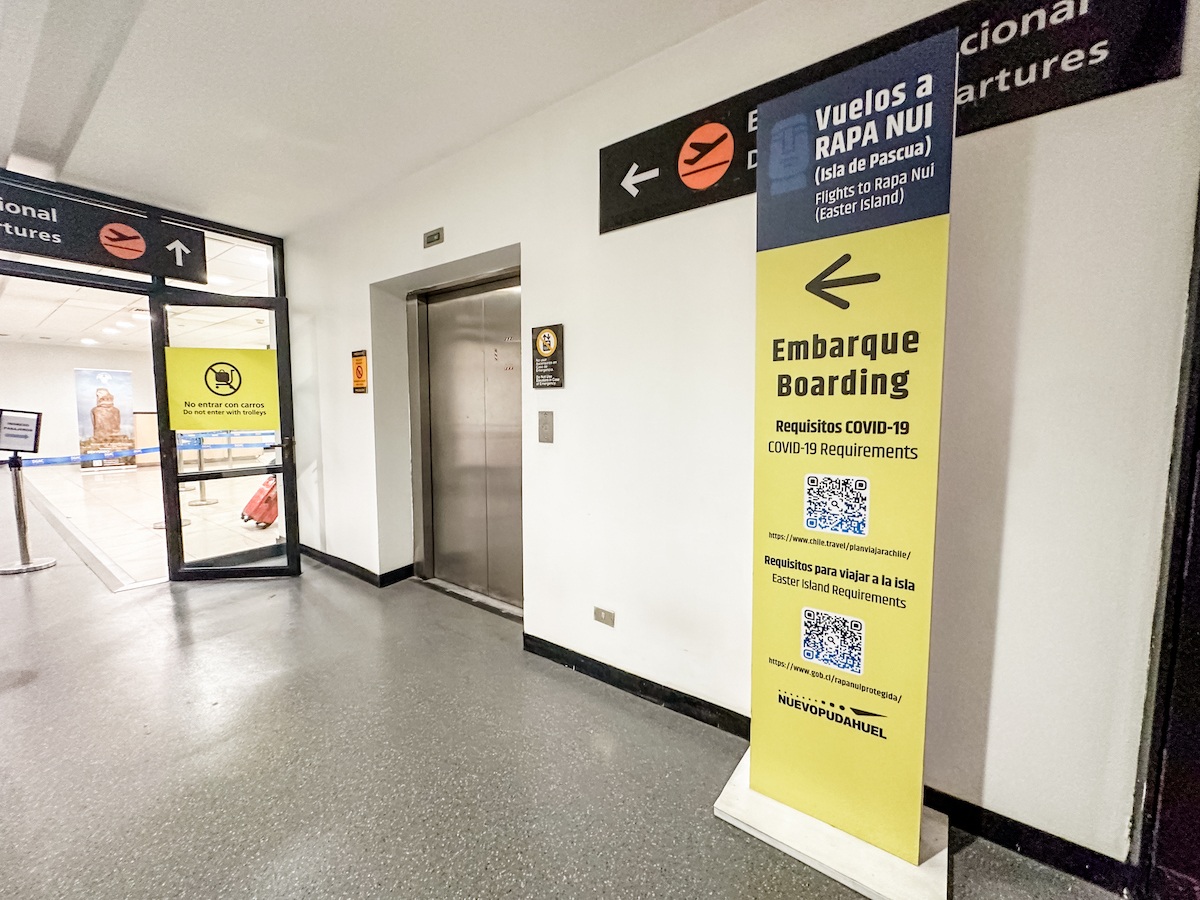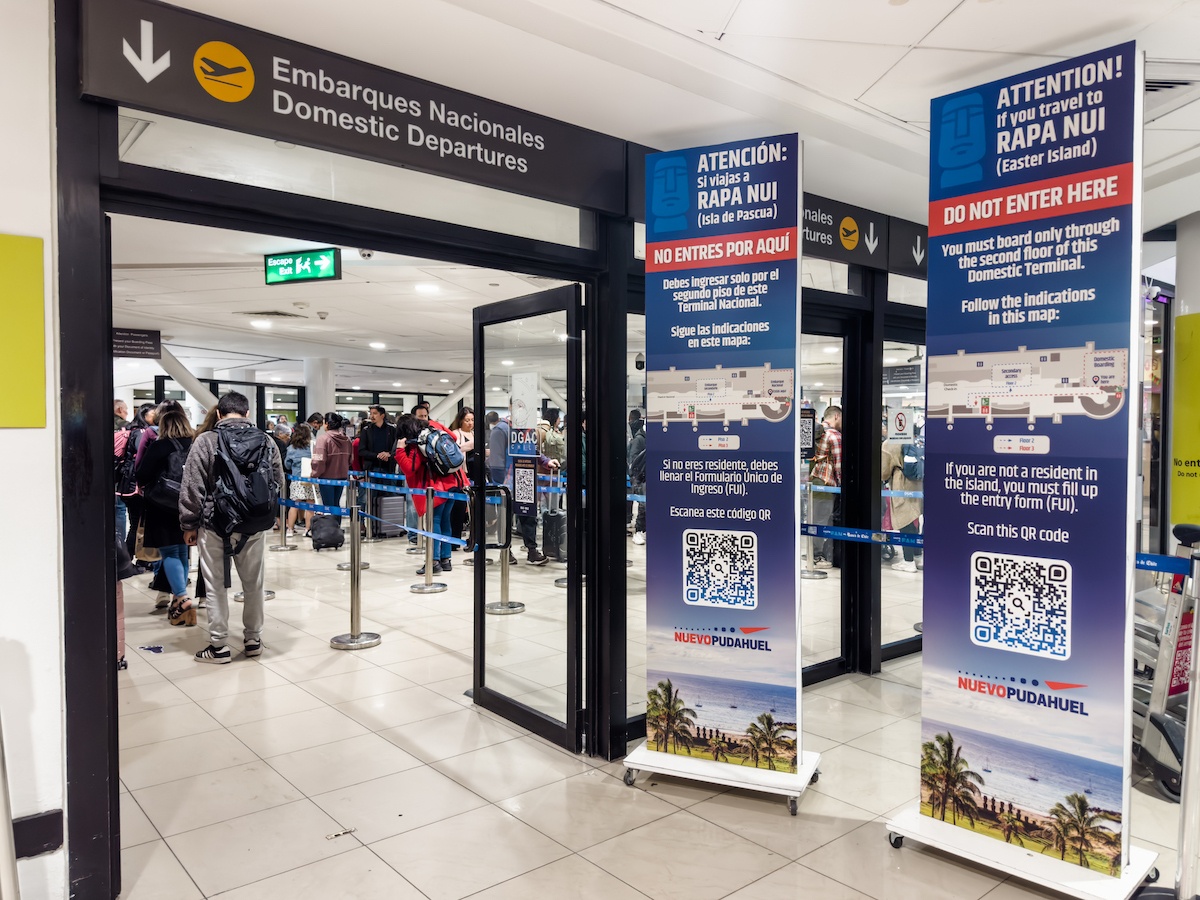With its mysterious Moai, polynesian culture and sweeping coastlines, Easter Island (Rapa Nui) is one of the world’s most fascinating, off-the-beaten-path destinations.
The only way to get to Easter Island is a five hour flight from Santiago, Chile, and the adventure begins before even setting foot on the plane (yes, the actual process of buying a ticket and getting to the boarding gate can be THAT confusing).
From how to save on flights to what you’ll need to do before leaving for Rapa Nui, here are some helpful tips to know before travelling to Easter Island.

Globe Guide note: There’s a lot of outdated information about Easter Island online, since there have been some major changes in the past few years. I visited in November 2023, so everything you’ll read here is the most up to date info you’ll find.

It’s not really called Easter Island
Once you set foot on Easter Island, you won’t see a single reference to that name. Instead, everyone uses its proper name, Rapa Nui.

Rapa Nui is the Indigenous term that’s been used for generations—Easter Island is the result of a colonizer who arrived on the island, assumed he’d discovered it, and since he made landfall on Easter Sunday it became known as Easter Island. As white guys tended to do in those days *ahem Christopher Columbus*.
You’ll also see reference to ‘Isla de Pascua,’ which is the Spanish translation of Easter Island.
There are now efforts underway to make the proper Rapa Nui name more mainstream; the Chilean government passed legislation that going forward Rapa Nui will be used in all official references to the island.

How to get a flight to Easter Island for half price
Ready for the most ridiculous travel hack? To get your flight to Easter Island from Santiago for half price, book through the Chilean version of LATAM’s site, not the international (USA or Canada) versions it will try to redirect you to.
Yes this means you’ll have to checkout in Spanish and pay in pesos, but to save literally hundreds of dollars it’s worth it.

Important notes about how to get to Easter Island (Rapa Nui)
LATAM used to operate flights between Rapa Nui and Santiago, and Rapa Nui and Tahiti, but ceased the Tahitian operations during the pandemic.
Currently the only option for flying to Easter Island is via Santiago, and the actual process of getting through the airport can be a bit tricky since it requires additional screening.
READ MORE: How to get to Easter Island (Rapa Nui): Top tips and tricks

Flights depart from the domestic terminal, however—and this is very important—passengers do not go through the regular domestic security line. Instead, there’s a special screening area located down one level where the agents will confirm passengers have filled out the mandatory entry form which includes proof of accommodation and a return flight (fill it out ahead of time, since it’s a bit tedious).

They’ll also give you a stamped piece of paper before heading through security and to the gate, which you’ll need to present at boarding.
I personally know multiple people who didn’t know this and went through the regular security line, and got quite the shock when they found out while boarding that they had to go all the way back through the airport to go through the special security process.

Santiago airport has finally put up a sign at domestic security reminding passengers not to go through that gate, and there’s also a sign by the staircase and elevators leading to the lower level, so be sure to pay attention to them!

A final tip about the Santiago-Easter Island flight: even though it’s a domestic flight plan to arrive at least two to three hours early if checking bags, since that line can be quite long and security takes longer than usual.

Traveling to Easter Island is not cheap
While South America overall tends to be known for budget destinations, that’s not the case here in Rapa Nui. It’s isolated, many items need to be imported, and there are only so many accommodations to choose from which means visitors will pay a premium.
Expect to shell out $70-200 USD per tour, $80 for the parks pass, $80-150/day to rent a scooter or car (taxis are quite expensive), and at least $40 per person for dinner.

Accommodation is where the costs really add up: basic rooms start around $200, while luxe properties like Nayara Hangaroa and explora Rapa Nui cost more than $1000/night.


Bring sunscreen
It gets hella hot here even if the forecast doesn’t look like it–something about being close to the equator and all those reflections off of the water.
Be sure to pack plenty of sunscreen: if you forget, there are a couple of pharmacies in Rapa Nui that sell it for about $15 a bottle.

You’ll need a guide
Bad news, adventurous travellers: gone are the days where you could hop a scooter and explore on a whim.
Tourists are no longer permitted to visit any of the sites in the national park (which is about 45 per cent of the island) without an accredited guide—a major change introduced in recent years to help protect the fragile sites.

There are plenty of half-day, full-day and multi-day tours for seeing the best things to do on Easter Island, which can be booked through your hotel or by heading into Hanga Roa. Expect to spend around $70 for a half day tour.
On a positive note, this means you’ll learn much more about the significance of each site, since there aren’t very many interpretive signs around.

Book one of these guided tours of Easter Island:
Don’t forget your parks pass
Even when you shell out for all those tours, you’ll also need to buy a national parks pass which costs $80 USD. While there’s one place in the capital Hanga Roa to pick one up, it’s easier to purchase online ahead of time.

Bring a copy of it on all tours, as they’re stamped/scanned at the entrance to each site and visitors are not permitted through without it. While most sites can be visited as often as you want, Rano Raraku (the quarry) and Orongo are permitted only once.
Globe Guide tip: If you show a PDF version on your phone vs a paper copy, staff usually only glance at it and likely won’t stamp/scan it which means you might be able to visit Rano Raraku and Orongo multiple times.

Rent a ride
One of the best ways to explore Easter Island is to hit the road. Suzukis, ATVs, motorbikes and scooters are the preferred mode of transport here, which can be rented at one of the handful of rental car companies in Rapa Nui.

Prices vary a bit so be sure to shop around, and expect to pay around $70/day for a scooter or ATV, and up to $150/day for an automatic vehicle. Insurance isn’t a thing around here, so pay with a credit card that includes rental insurance for peace of mind.
Some companies might also ask for an International Drivers License, or to see proof of a motorcycle (Class B) license to rent an ATV or scooter…although I don’t have either, and still managed to rent an ATV.

Since many sites can only be visited with a guide, the ones to drive to on your own are:
- Anakena Beach
- Ovahe Beach
- The rim of the Rano Kau crater
- Tahai (a great sunset spot)
- The Maunga Terevaka hike (about one hour)
- The Vaitea hike (about one hour)
It’s OK to pullover and take a quick photo if you pass protected sites, but visitors are only able to go in and explore them with a guide.

Double check the time
Rapa Nui is in the EASST (Easter Island Summer Time) timezone, two hours behind Santiago. While smartphones normally update the time automatically once you land somewhere new, for some strange reason this seems to be the exception, not the rule on Easter Island.
It took me an entire afternoon and one very awkward conversation about why sunset happy hour hadn’t started yet, for me to realize that my iPhone was still showing Santiago time—apparently it’s a common problem so be sure to double-check so you don’t sleep through a sunrise tour!

You can get a special passport stamp
Love the feeling of a new stamp in your passport? You’ll get one when arriving in Chile, but since Rapa Nui is part of the same country there isn’t another one for the island. However, there’s a tourist information office in Hanga Roa where they’ll give you a free souvenir stamp.
Just keep in mind that there can potentially be issues with novelty stamps in a passport. I’ve personally never had a problem and have gotten them in Liechtenstein and at Machu Picchu, and I grabbed one in Rapa Nui too since I was about to renew and get a new passport anyway.

YOU MIGHT ALSO ENJOY:
- 5 reasons to go backpacking in South America
- Visiting Machu Picchu: Travel tips for exploring the world wonder
SHARE THE PINSPIRATION! CLICK THE IMAGES BELOW TO PIN:
This post may contain affiliate links, which Globe Guide receives compensation for at no additional cost to you.




